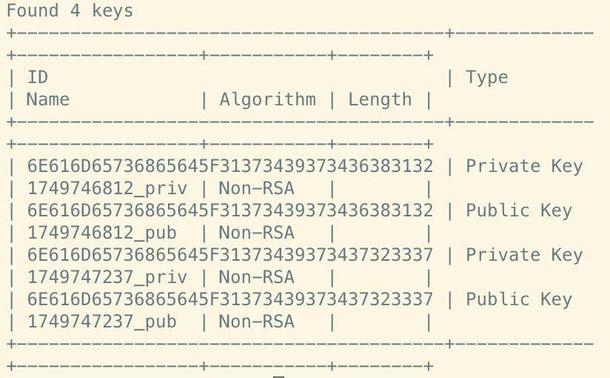Thinking of moving my domains' DNS hosting to deSEC at https://desec.io. They require enabling #DNSSEC. Any reasons this a bad idea? #DNS.
#DNSsec
Yesterday I started testing the #DNS4EU servers on my #pihole regarding ad blocking and child protection. Seems to work well so far after using it through the day.
https://www.joindns4.eu/learn/dns4eu-public-service-launched
Then I stumbled over the article below. I definitely need to look into the details myself.
https://cybernews.com/security/european-independent-dns-relies-on-cloudflare-google/
What‘s your thoughts on this? Is it a usable alternative?
Protect your financial institution’s reputation and customer trust. Choose DNSimple for your .BANK domain hosting.
🔐 Help your customers bank securely
⛔ Eliminate spam and phishing
📈 Enhance your brand with new opportunities
DNSimple's managed #DNS service is fully compliant with all .BANK security requirements. Including #DNSSEC, multi-factor authentication, strong encryption, and #DDoS protection.
PowerDNS Recursor 5.3.0-alpha1 Released
https://blog.powerdns.com/powerdns-recursor-5.3.0-alpha1-released
#dns #dnssec
New zone signing key added to root. Verisign's DNZviz had trouble getting TCP responses at this time.
https://dnsviz.net/d/root/aFUQrA/dnssec/?rr=all&a=all&ds=all&doe=on&ta=.&tk=
Everything ok now.
First beta of PowerDNS DNSdist 2.0.0 Released
https://blog.powerdns.com/2025/06/20/first-beta-release-of-powerdns-dnsdist-2.0.0
#dns #dnssec
🌖 DNSSEC 101:我們為什麼需要 DNSSEC?
➤ 保護網路根基:DNSSEC 的重要性
✤ https://howdnssec.works/why-do-we-need-dnssec/
DNS(網域名稱系統)最初設計時未將安全性納入考量,容易受到篡改。DNSSEC(網域名稱系統安全延伸)正是在此背景下應運而生的,它透過驗證 DNS 回應的真實性,確保使用者能正確連接到目標網站,並防止惡意重導。雖然 DNSSEC 不像 HTTPS 那樣提供加密功能,但它能偵測 DNS 資料是否被竄改。
+ 聽起來 DNSSEC 就像是網路世界的身份證,可以驗證網站的真偽,讓人更安心上網!
+ 以前總覺得 DNS 只是個電話簿,沒想到它其實也需要安全防護,DNSSEC 真是個重要的技術。
#網路安全 #DNS #DNSSEC
🌮 A taco explains how DNSSEC works! via @trusty #taco #dnssec https://howdnssec.works
Ah, DNSSEC—the digital equivalent of locking the barn door after the data has bolted 🐎🔒. Who knew securing a system designed with all the foresight of a toddler with a crayon could be so "urgent"? 😂 Clearly, the internet was built on trust, much like a pyramid scheme but with fewer yachts. 🛥️
https://howdnssec.works/why-do-we-need-dnssec/ #DNSSEC #internetsecurity #cybersecurity #humor #trustissues #HackerNews #ngated
Mongolia's IDN TLD, мон., just switched from the very old algorithm 5 (RSA-SHA1) to elliptic curves \o/
Identity digital rolling keys after delegation change. There’s no going back now.
#dns #dnssec
https://mastodns.net/@diffroot/114700759330727364
#DNS #DNSSEC Le Gabon est désormais signé.
https://dnsviz.net/d/www.nic.ga/aFFxSw/dnssec/
And we're also looking for a Go dev!
also available in English:
Extended DNS Errors used in DNS software and services -- Modern, standardised function call for user applications still needed
https://www.sidn.nl/en/news-and-blogs/extended-dns-errors-used-in-dns-software-and-services
The Extended DNS Errors (EDE) introduced by RFC 8914 seem to be a useful addition to the DNS protocol.
However, there’s still a need for a new or extended function call to enable (stub) resolvers to relay EDE error codes to user applications that send them queries.
op SIDN.nl:
Extended DNS Errors vinden toepassing in DNS-software en -diensten -- Moderne, gestandaardiseerde functie-call voor gebruikersapplicaties ontbreekt nog
https://www.sidn.nl/nieuws-en-blogs/extended-dns-errors-vinden-toepassing-in-dns-software-en-diensten
De Extended DNS Errors (EDE) die RFC 8914 introduceerde blijken een belangrijke toevoeging aan het DNS-protocol.
Wat nog ontbreekt is een nieuwe of uitgebreide functie-call waarmee (stub) resolvers EDE-foutcodes aan hun aanroepende gebruikersapplicatie kunnen doorgeven.
I've noticed that in recent days the `LI` domain has crept up over 10% errors when querying signed domains. It's about 10.2% which is significantly higher than other Top Level Domains
It isnt in my top ten list so I don't publish the results on my report page. I have the data tho.
If you're associated with the TLD I'd love to hear if you have any thoughts on why.
https://kalfeher.com/analysis/cds-charts/#7-dns-connection-error-rate-per-tld
And yes, it works! Here are #DNSSEC keys in the YubiHSM, created via PKCS#11 using kmip2pkcs11 with KMIP queries sent by domain KMIP key code.
The goal for this approach is to shield an application against an untrusted PKCS#11 library.
Little Friday shout-out to @andreas for setting us up with a YubiHSM so we can test our KMIP and PKCS#11 code for our #DNSSEC signer Nameshed. 💚 Thanks a lot for supporting #OpenSource! #DNS #rustlang https://github.com/NLnetLabs/kmip2pkcs11

